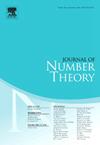关于Z[n3]的因子环
IF 0.6
3区 数学
Q3 MATHEMATICS
引用次数: 0
摘要
我们给出了Z[n3]的因子环的结构的描述,其中(不失一般性)n是一个正整数而不是立方体。例如,我们证明了Z[n3]/(a+bn3+cn23)同构于整数环模|N|,如果gcd (b2−ac,N)=1,其中N=a3+nb3+n2c3−3nabc是生成子的范数。我们还刻画了其他整数a,b,c的这些因子环的结构。最后,我们描述了Z[n3]/I对于某些非主理想I。我们也给出了Z[n3]中不可约素元素的许多推论,并给出了许多例子。本文章由计算机程序翻译,如有差异,请以英文原文为准。
On the factor rings of Z[n3]
We give a description of the structure of factor rings of where (without loss of generality) n is a positive integer which is not a cube. For example, we prove that is isomorphic to the ring of integers modulo , if where is the norm of the generator. We also characterize the structure of these factor rings for others integers . Finally, we describe for certain non-principal ideals I. We also present many corollaries regarding irreducible and prime elements in and give numerous examples.
求助全文
通过发布文献求助,成功后即可免费获取论文全文。
去求助
来源期刊

Journal of Number Theory
数学-数学
CiteScore
1.30
自引率
14.30%
发文量
122
审稿时长
16 weeks
期刊介绍:
The Journal of Number Theory (JNT) features selected research articles that represent the broad spectrum of interest in contemporary number theory and allied areas. A valuable resource for mathematicians, the journal provides an international forum for the publication of original research in this field.
The Journal of Number Theory is encouraging submissions of quality, long articles where most or all of the technical details are included. The journal now considers and welcomes also papers in Computational Number Theory.
Starting in May 2019, JNT will have a new format with 3 sections:
JNT Prime targets (possibly very long with complete proofs) high impact papers. Articles published in this section will be granted 1 year promotional open access.
JNT General Section is for shorter papers. We particularly encourage submission from junior researchers. Every attempt will be made to expedite the review process for such submissions.
Computational JNT . This section aims to provide a forum to disseminate contributions which make significant use of computer calculations to derive novel number theoretic results. There will be an online repository where supplementary codes and data can be stored.
 求助内容:
求助内容: 应助结果提醒方式:
应助结果提醒方式:


